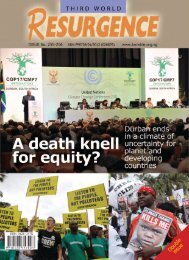Plantations, poverty and power - Critical Information Collective
Plantations, poverty and power - Critical Information Collective
Plantations, poverty and power - Critical Information Collective
Create successful ePaper yourself
Turn your PDF publications into a flip-book with our unique Google optimized e-Paper software.
40<br />
Evans argues that replacing grassl<strong>and</strong> with pine plantations created “a large area of ‘new’ habitat,<br />
structurally much more diverse than grass veld”. He adds that by excluding humans from the ecosystem,<br />
“the large area of forest [sic] is now excellent wildlife cover”. While he admits that no systematic<br />
monitoring of wildlife has been carried out, Evans reports that since 1968, the numbers <strong>and</strong> varieties of<br />
animals have increased, “<strong>and</strong> today greatly exceed those of the pre-existing grassl<strong>and</strong>”. Evans explains<br />
that this is “because the large plantations provide shelter <strong>and</strong> refuge from man.” He continues,<br />
“In the Usutu forest [sic], hunting is forbidden, man [sic] finds the monoculture relatively unattractive for<br />
recreation, <strong>and</strong> the distance of sight, hearing, <strong>and</strong> smell are all reduced; thus animals are safer <strong>and</strong> more<br />
protected.” 171<br />
In its 2006 assessment of the Usutu plantations for FSC certification Woodmark came to a different<br />
conclusion. In the plantations, “there is very little wildlife,” wrote Woodmark’s assessors. Any wildlife in<br />
the plantations is “Due to the close proximity of Usutu to the Mlilwane Game Sanctuary” <strong>and</strong> “a number<br />
of interesting animal sitings [sic] have been noted by foresters <strong>and</strong> visitors to Usutu.” 172<br />
In order to produce his optimistic analysis of Sappi’s plantations, Evans introduces the concept of<br />
“narrow-sense sustainability”. This refers only to wood yields over several rotations, to determine<br />
whether trees “can be grown indefinitely for rotation after rotation on the same site without serious risk to<br />
their well being.” 173 Evans thus excludes the social <strong>and</strong> environmental impacts of tree plantations from<br />
his analysis <strong>and</strong> is looking only at the technical aspects of industrial tree plantations. Nevertheless, he<br />
makes public statements that plantations in Swazil<strong>and</strong> are “sustainable”, without making any mention of<br />
“narrow-sense sustainability”. 174 He has also done so in writing:<br />
“There is no general evidence of declining yields resulting from intensive plantation forestry of<br />
cultivation of three crops of the same species on the same site. The prospects for this continuing are good.<br />
With good husb<strong>and</strong>ry Usutu’s plantation forestry is demonstrably <strong>and</strong> wholly sustainable.” 175<br />
Evans fails to mention that what he’s talking about here is “narrow-sense sustainability”. It is nonsense to<br />
conclude from measurements of tree growth that Swazil<strong>and</strong>’s industrial tree plantations are “wholly<br />
sustainable”.<br />
Although Woodmark recommended that Sappi should be certified by FSC, in its assessment Woodmark<br />
documented several serious problems with Sappi’s plantations. Perhaps the most important was the<br />
171 Julian Evans (1988) “The Usutu forest: Twenty years later”, Unasylva, Vol. 40, No. 159, Food <strong>and</strong> Agriculture<br />
Organization of the United Nations.<br />
http://www.fao.org/docrep/s5780e/s5780e04.htm#the%20usutu%20forest:%20twenty%20years%20later<br />
172 “Woodmark Forest Certification Public Report, Sappi Usutu”, Woodmark, Soil Association, July 2006.<br />
http://www.organicweek.org/web/sa/saweb.nsf/librarytitles/22D0E.HTMl/$file/Usutu%20FM%20S1%20report%20FINAL<br />
.xls<br />
173 Julian Evans (1999) “Sustainability of Forest <strong>Plantations</strong>: The evidence. A review of evidence concerning the<br />
narrow-sense sustainability of planted forests”, Department for International Development, May 1999.<br />
174 Wally Menne <strong>and</strong> Ricardo Carrere (2007) “Swazil<strong>and</strong>: The myth of sustainable timber plantations”, World<br />
Rainforest Movement, March 2007, pages 7-8. http://www.wrm.org.uy/countries/Swazil<strong>and</strong>/book.html<br />
175 Julian Evans (1995) “A Further Review of Third Rotation Productivity in the Usutu Forest, Swazil<strong>and</strong>”, UPCO<br />
Forest Research Report 16/95, cited in Peter Whitfield (1996) “Usutu Pulp Company Limited, Swazil<strong>and</strong>. A successful<br />
Integrated Industrial Forestry Project”, Case study prepared for the UNEP/World Bank Africa Policz Forum, 29-30 August<br />
1996, Nairobi. http://www.worldbank.org/afr/afr_for/fulltext/swazlnd.doc















